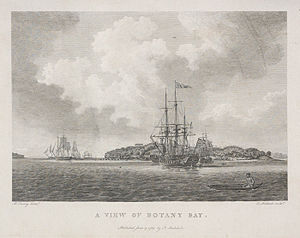
There are 20 known contemporary accounts of the First Fleet made by people sailing in the fleet, including journals (both manuscript and published) and letters.[1][2] The eleven ships of the fleet, carrying over 1,000 convicts, soldiers and seamen, left England on 13 May 1787 and arrived in Botany Bay between 18 and 20 January 1788 before relocating to Port Jackson to establish the first European settlement in Australia, a penal colony which became Sydney.
At least 12 people on the fleet kept a journal of their experiences, some of which were later published, while others wrote letters home during the voyage or soon after their arrival in Australia. These personal accounts of the voyage were made by people including surgeons, officers, soldiers, ordinary seamen, and Captain Arthur Phillip, who commanded the expedition. Only one known account, that of James Martin, was by a transported convict. Their journals document the day-to-day experiences of those in the fleet, and record significant events including the first contact between the British settlers and the Aboriginal people of the area.
In 2009, the manuscript journals were included in The Australian Memory of the World Register, a regional register associated with the UNESCO international Memory of the World programme.[3][4]
- ^ "Journals from the First Fleet". Discover Collections. State Library of NSW. Archived from the original on 5 June 2014. Retrieved 28 November 2013.
- ^ "First Fleet scribes". Webster World. Archived from the original on 13 December 2013. Retrieved 28 November 2013.
- ^ "First Fleet Journals – Citation #33". Australian Memory of the World Program. UNESCO. Archived from the original on 13 December 2013. Retrieved 5 December 2013.
- ^ Macy, Jennifer (14 October 2009). "First Fleet journals listed on UNESCO register". ABC News Blog. Archived from the original on 28 December 2013. Retrieved 18 December 2013.